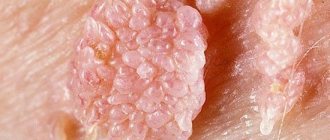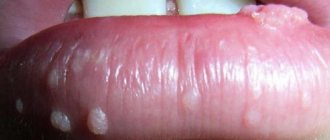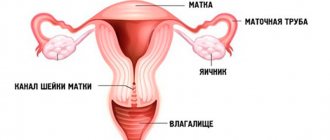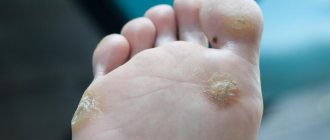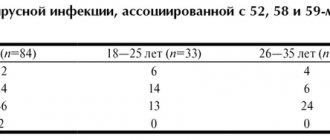Pointed penile papillomas are a pathology characterized by the appearance of pointed (finger-shaped, papillary) growths on the mucous membrane of the penis. The neoplasm is benign, but due to certain mutations and external and internal factors it can develop into malignant.
Pathology occurs in 35% of cases in men aged 20 to 35 years. After 35 years, the risk of developing pathology decreases. Age-related criteria for the disease are associated with the sexual activity of a young person.
The risk of partner infection is 100%. However, the probability of developing genital warts is only 70%.
Causes and pathogenesis
The cause of the appearance of genital warts is the human papillomavirus (HPV) of certain strains: 6,11,42,43 and others.
A person becomes infected with it from a partner through sexual contact; household transmission is likely. There are also possible cases of infection from mother to fetus during childbirth.
If the immune system is able to restrain the development of pathology, no symptoms occur. However, even after proper treatment, the virus does not disappear from the body, as if dying out. When health conditions deteriorate, HPV is activated, leading to the appearance of genital warts.
MAKE AN APPOINTMENT WITH AN ANDROLOGIST
Klokov Andrey Nikolaevich
Urologist-andrologist, doctor of the highest category
Make an appointment
Removing condylomas with liquid nitrogen
If a laser destroys condyloma by heating, then liquid nitrogen does this using low temperature. In the language of doctors, this is called cryosurgery. Compared to laser and radio wave surgery, it has a number of disadvantages:
- Usually a bubble remains at the intervention site, then it is opened, after which it takes about 2 more weeks to heal.
- It is more difficult to control the area of influence. Cold damages healthy tissue 1–2 cm around the condyloma.
- For 1–2 days after surgery, you experience quite severe pain.
Risk factors
According to statistics, the human papillomavirus occurs in 8 out of 10 men, and in a latent form. “Sleeping” HPV does not cause discomfort or the appearance of genital warts. However, there are a number of external and internal factors that lead to activation of the virus and growths on the penis:
- Hypothermia;
- Other viral or bacterial, fungal infections;
- Smoking and alcohol abuse;
- Hormonal changes;
- Abuse of strong medications;
- Strong physical activity;
- Autoimmune pathologies;
- AIDS;
- Frequent change of sexual partners;
- Impaired metabolism;
- Congestion in the pelvis.
Often a man has several triggers at once that contribute to the appearance of condylomas.
What is the prevention of diseases caused by HPV?
Examination of sexual partners of patients with diseases caused by HPV has no proven value in terms of preventing their occurrence/recurrence. However, theoretically, timely and complete removal of OCs and intraepithelial lesions can reduce the risk of these diseases, including cervical cancer. It has not been proven that condoms can protect against HPV transmission, but their use reduces the risk of developing OCs and cervical cancer. The most promising method of preventing and treating the early stages of diseases caused by HPV are specific polyvalent (for HPV types 6, 11, 16 and 18) vaccines, which are currently in clinical trials. In summarizing the known information about diseases caused by HPV, the US Center for Disease Control (CDC) draws attention to the public's knowledge of the following key points:
- HPV is an extremely common STD
- It is rarely possible to identify the source of infection due to the highly variable incubation period
- The natural progression of diseases caused by HPV is often benign, and treatment sometimes requires several months. Relapses often occur (up to 50% of cases).
- OCs are most often caused by HPV types that do not cause cervical cancer
- Infectiousness of sexual partners decreases over time
- The effectiveness of condoms in protecting against HPV has not been proven. However, the use of condoms by patients with HPV for new sexual contacts is considered mandatory.
- You should tell new sexual partners that you have previously been infected with HPV
Women, especially those of sexually active age, need to know that the basis for the prevention of cervical cancer is mandatory annual preventive examinations by a gynecologist with a cytological examination of the cervical epithelium according to Papanicolaou, as well as, if necessary, HPV typing, colposcopy and cervical biopsy.
Symptoms
Condylomas acuminata are pale red, elongated, on a thin stalk or wide base, and consist of fibroepithelial tissue. They are always single, but often form in close proximity to others, which is similar to multiple growths. Size – no more than 0.5-1 cm in diameter. If the formation is damaged, it may begin to grow.
The most common localization of genital warts is the inner layer of the foreskin and the scaphoid fossa. Less commonly, neoplasms are found in the coronal sulcus of the head of the penis. Sometimes they appear in the urethral canal or spread along the shaft of the penis.
Due to a defect in the penis, a man additionally develops depression, becomes irritable, and refuses intimacy. Sometimes the patient is so depressed due to the proliferation of many tumors that potency and libido are reduced to zero.
The pathology gets worse because the man is embarrassed to see a doctor.
In addition to aesthetic discomfort, the formations cause other inconveniences: they may be damaged during sexual intercourse, which leads to bleeding and the risk of additional infection. If dirt and bacteria get into the wound, itching and burning are possible.
Viral tumor specialists. Which doctor treats condylomas in men?
To check suspicious growths, you need to contact a dermatologist. This doctor specializes in skin diseases and growths. Including on the genitals.
There is nothing wrong with being examined by a doctor, so don’t put off diagnosis until too late. The sooner you are diagnosed, the sooner you will understand what to do about intimate warts.
Sometimes it's good to wait.
And in other cases, doctors recommend urgent surgery.
Each patient has a different situation.
Now you know which doctor treats genital warts in men and you can undergo a timely examination before dangerous complications arise. All that remains is to find a suitable medical center.
Diagnostics
The examination of the patient begins with a questioning and examination. An experienced doctor will immediately identify genital warts. Laboratory tests play an important role: it is important for specialists to find out which strain of the virus is developing in the body.
In addition to the PCR test and immunological study, the urologist needs to find out the quantitative and qualitative composition of the blood and determine the ratio of hormones. Tests for sexually transmitted infections are required.
Additionally, doctors take urine and prostate secretions for examination to rule out inflammatory reactions and other pathologies of the urethra and prostate.
Next, the doctor proceeds to instrumental diagnostics. Urethroscopy will help exclude the presence of formations in the urethra. Histology is necessary to determine the nature of the neoplasm tissue: benign or malignant.
Advantages of radio wave surgery using the Surgitron device
Doctors at the ProfMedLab clinic remove genital warts using the modern Surgitron radio wave surgery device. The principle of the method is that the device generates high frequency radio waves. Coming into contact with tissues, they evaporate liquid from cells, that is, they actually destroy them. Radio wave surgery has some advantages:
- Purposeful action. Only affected tissues are destroyed, while surrounding healthy tissues remain untouched. In this regard, radio wave surgery is a more gentle method compared to laser.
- Good cosmetic effect. After removal of tumors using the Surgitron apparatus, barely noticeable scars remain.
- Full control over the process. The surgeon can precisely control the area and depth of tissue removed.
- Bloodless intervention. There is no bleeding during genital wart removal.
- Fast recovery. The wound heals completely within a few days. There is virtually no pain or swelling.
Treatment
Pathology requires conservative and radical treatment methods. Only after complete therapy is it possible to eliminate the consequences and contain relapses of the viral infection.
First of all, doctors choose options for surgical removal of genital warts. To minimize complications, the andrologist resorts to minimally invasive techniques:
- Laser vaporization - the beam seems to evaporate a condyloma;
- Radio knife – low-frequency radio waves are directed at pathological tissues;
- Cryodestruction - the use of liquid nitrogen to freeze the formation;
- Electrocoagulation is the effect of electric current.
Each of the methods has contraindications.
The impact of a laser beam and other physical forces and devices on the tissue of neoplasms leads to their complete removal without the likelihood of bleeding.
If the lesions of the penis are minimal, you can cope with local medications: gels, creams or injections based on an antiviral agent. In this case, the chemical active substances simply burn the condyloma from the inside, leaving a dark spot in its place.
Next, the doctor prescribes medications that help control the human papillomavirus in the body:
- Oral antivirals;
- Immunostimulating;
- Restoring metabolism;
- Vitamin complexes for men's health.
If a man is diagnosed with an additional infection or hormonal imbalance, consultation with an appropriate specialist is indicated.
HPV cannot be completely cured; therefore, the risk of genital warts always exists. However, preventive measures contribute to stable remission.
| Consultation with an andrologist RUB 1,200. Make an appointment | or call +7 Laboratory Ave. 20, bldg. 3 +7 st. Composers, 4 |
Methods for destroying growths. How to get rid of genital warts in men
Not all patients seek urgent removal of genital warts - quite often the tumors do not cause discomfort and are almost invisible. Just a few tiny growths. They are not even felt.
Do they need to be removed?
Decide for yourself - although these genital warts don't bother you, they are still contagious and increase your chances of passing the virus on to your partner. You can wait until the genital warts disappear on their own. But most of these viral tumors disappear within only two years, and not all patients want to endure that long.
Therefore, let's return to treatment options.
In many cases, doctors first prescribe topical treatments—creams and ointments containing chemicals that slowly destroy the warts.
With this treatment, surgery is not necessary. However, there are also disadvantages - these remedies are not very effective and usually begin to work only with repeated use. So the therapy will continue for a long time. In addition, she has a high risk of recurrence of growths.
Operations are more reliable. They allow you to get rid of genital warts in men in almost all cases. Unfortunately, the guarantee is not 100%.
Basic procedures:
- Cryotherapy
The doctor freezes the growth with liquid nitrogen. The tumor gradually dies and falls off, and new healthy skin grows under it. Sometimes several sessions are needed.
- Surgical excision
The doctor cuts off genital warts with a scalpel or other instruments. Usually it also removes a thin layer of skin around the growths. For complete removal. After the operation, wounds remain, and then scars may appear.
- Electrocoagulation
The doctor burns the tumor with high-frequency electric current. A small wound remains. It heals in a few weeks.
- Laser therapy
The doctor removes condylomas with a beam of light. This method is well suited against growths that are difficult to remove with other methods. The wound from the operation becomes covered with a crust and heals completely in three weeks.
A little advice - do not sign up for surgery immediately when you discover genital warts.
Better go for a checkup. It is quite possible that genital warts will disappear without expensive treatment.
However, it is not worth delaying therapy for a long time - especially when various complications appear that make life with growths difficult. In such cases, you need the help of a doctor.
